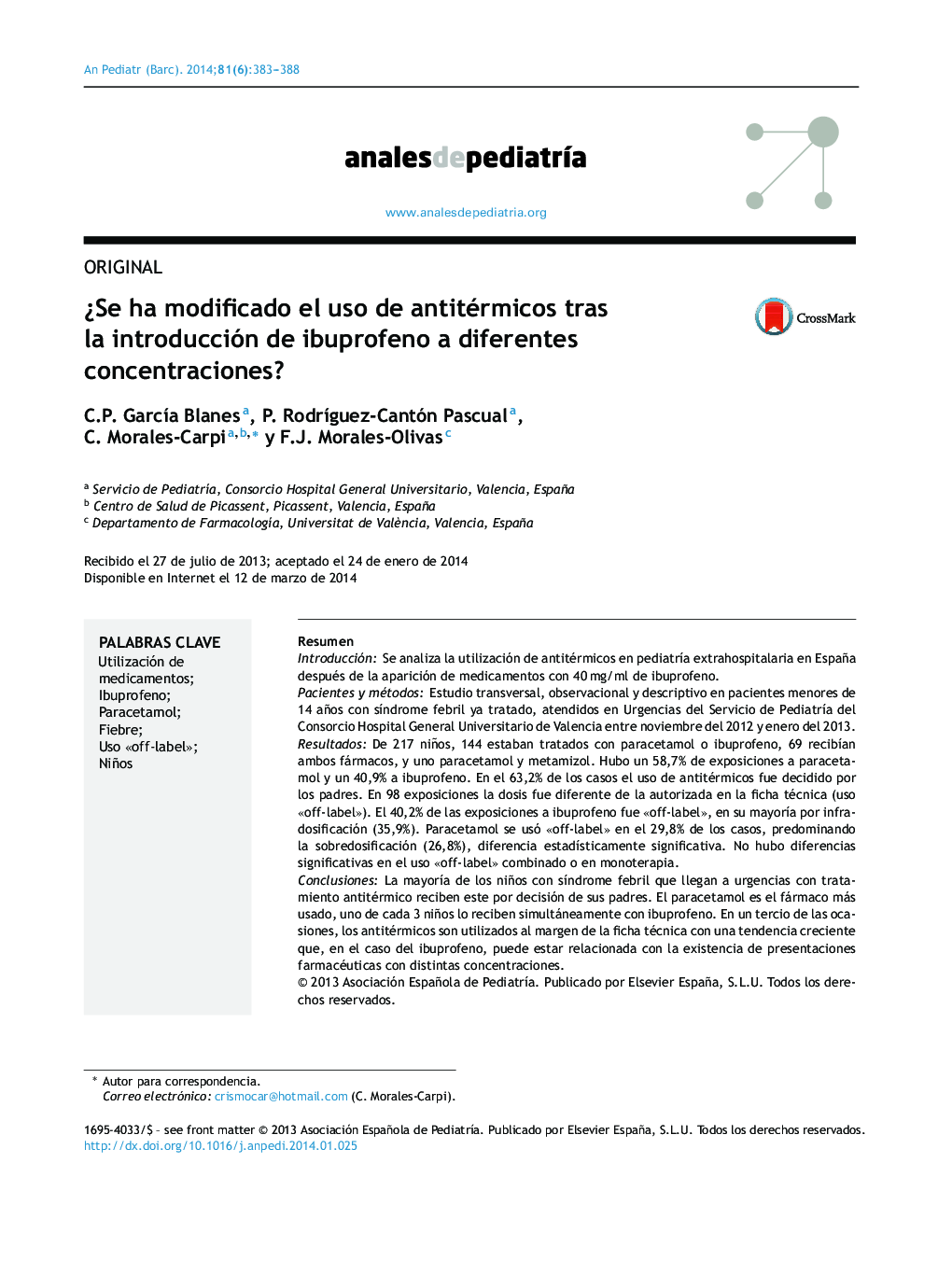| کد مقاله | کد نشریه | سال انتشار | مقاله انگلیسی | نسخه تمام متن |
|---|---|---|---|---|
| 4141198 | 1272321 | 2014 | 6 صفحه PDF | دانلود رایگان |

ResumenIntroducciónSe analiza la utilización de antitérmicos en pediatría extrahospitalaria en España después de la aparición de medicamentos con 40 mg/ml de ibuprofeno.Pacientes y métodosEstudio transversal, observacional y descriptivo en pacientes menores de 14 años con síndrome febril ya tratado, atendidos en Urgencias del Servicio de Pediatría del Consorcio Hospital General Universitario de Valencia entre noviembre del 2012 y enero del 2013.ResultadosDe 217 niños, 144 estaban tratados con paracetamol o ibuprofeno, 69 recibían ambos fármacos, y uno paracetamol y metamizol. Hubo un 58,7% de exposiciones a paracetamol y un 40,9% a ibuprofeno. En el 63,2% de los casos el uso de antitérmicos fue decidido por los padres. En 98 exposiciones la dosis fue diferente de la autorizada en la ficha técnica (uso «off-label»). El 40,2% de las exposiciones a ibuprofeno fue «off-label», en su mayoría por infradosificación (35,9%). Paracetamol se usó «off-label» en el 29,8% de los casos, predominando la sobredosificación (26,8%), diferencia estadísticamente significativa. No hubo diferencias significativas en el uso «off-label» combinado o en monoterapia.ConclusionesLa mayoría de los niños con síndrome febril que llegan a urgencias con tratamiento antitérmico reciben este por decisión de sus padres. El paracetamol es el fármaco más usado, uno de cada 3 niños lo reciben simultáneamente con ibuprofeno. En un tercio de las ocasiones, los antitérmicos son utilizados al margen de la ficha técnica con una tendencia creciente que, en el caso del ibuprofeno, puede estar relacionada con la existencia de presentaciones farmacéuticas con distintas concentraciones.
IntroductionDue to the emergence of new pharmaceutical presentations of ibuprofen (40 mg/ml), an analysis was made on the use of antipyretics in pediatric outpatient in Spain.Patients and methodsA cross-sectional, observational, descriptive study was carried out on a sample of children under 14 years old with treated febrile syndrome, seen in the Emergency Room of the Hospital General Universitario de Valencia from November 2012 to January 2013.ResultsOf the 217 children included, 144 were treated with paracetamol or ibuprofen, 69 received both drugs, and one received paracetamol and metamizol. There were 58.7% of exposures to paracetamol and 40.9% to ibuprofen. The parents decided the use of antipyretics in 63.2% of cases. In 98 exposures the dose was different from that authorized in the labeling of the drug (off-label use). Ibuprofen was used off-label in 40.2% of cases, mostly by underdosing (35.9%). Paracetamol was used off-label in 29.8% of cases, predominantly overdose (26.8%), with the difference being statistically significant. No significant differences were observed in the off-label use in either monotherapy or combined use. There were also no differences when antipyretics prescribed by doctors or given directly by parents were evaluated separately.ConclusionsThe majority of children with treated febrile syndrome seen in the Emergency Room were receiving antipyretic drugs after a parental decision. Paracetamol is the most commonly used drug and one in three children received it simultaneously with ibuprofen. The antipyretics were used off label in one-third of the cases. Off label use of ibuprofen is increasing, and is probably due to the existence of different pharmaceutical presentations.
Journal: Anales de Pediatría - Volume 81, Issue 6, December 2014, Pages 383–388